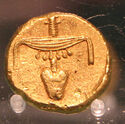| Twenty-Eighth Dynasty of Egypt | |||||
| |||||
|
| |||||
Egypt and surrounding nations following independence, 450 B.C.
| |||||
| Capital | Memphis | ||||
| Languages | Egyptian | ||||
| Religion | Egyptian Polytheism | ||||
| Government | Monarchy | ||||
| Pharaoh | |||||
| • | 459 - 436 B.C. | Psammuthes | |||
| • | 331 - 324 B.C. | Nectebano | |||
| Historical Era | Classical Era | ||||
| • | Victory of Psammuthes in the Battle of the Three Pharaohs. | 459 B.C. 459 B.C. | |||
| • | Conquest by Alexander the Great after the Battle of Gaza | 324 B.C. 324 B.C. | |||
| Currency | Stater | ||||
The Twenty-Eigth Dynasty of Egypt was the last reigning native dynasty in Egypt in the Classical time period, established following the Persian Twenty-Seventh Dynasty's expulsion by the Libyan rebel leader Inaros in 459 BC. While Inaros was successful in driving the Persians from the country he was not popular with other members of Egyptian nobility, who saw him as another foreigner unworthy of ruling Egypt.
These tensions soon boiled over and civil war nearly tore the country apart as two other nobles, Psammuthes and Amenirdisu, rose up and opposed Inaros' efforts to crown himself pharaoh. Psammuthes was able to gain the trust of the people and the religious class and at the Battle of the Three Pharaohs he defeated the other two pretenders, ousting Inaros and killing Amenirdisu, establishing the 28th Dynasty.
Inaros did not cease in his efforts to gain the throne, however, and merely retreated to the Libyan deserts in order to gather support with promises of loot and conquest. In 457 BC Inaros launched his invasion, expecting a swift victory, yet he was disappointed. After several hard fought battles and little success, his Libyan troops mutinied and turned Inaros over to Psammuthes, who promptly had him executed. With this threat to his rule finished, Psammuthes turned to other issues more prominent.
After several years of civil war, Psammuthes had to take into account the rivaling interests of the Persians, Nubians, and Athenians, all of which wanted to exert their influence over the country one way or another. To help manage these demands, Psammuthes helped rebuild Egypt's relatively decrepit military and re-establish trade in order to lessen foreign economic domination. This military would be crucial in fending off the Nubian invasion in the year 419 BC during the reign of his grandson Hakor.

The funeral mask of Psammuthes.
For much of the dynasty's history it had to balance the competing power balance amongst the Greek states as they battled for dominance over the Aegean Sea. Inaros obtained Egyptian independence thanks to Athenian aid, but Psammuthes and his successors were much more apathetic to Athenian interests, as they suspected the intent of the Athenians to colonize Egypt for themselves. Egypt was for the most part decidedly neutral in the struggles between Athens, Sparta, and Thebes over who would have hegemony over Greece, aligning itself only with any who would leave Egyptian independence well enough alone.
When Alexander the Great conquered Greece and marched into the Persian Empire, the 28th Dynasty hoped to take advantage of the distraction to invade the Levant and re-assert its authority over the region. This did not go unnoticed by Alexander, who promptly invaded the country following the conclusion to his campaigns in the east. Alexander defeated Psammuthes' descendent Nectebano at the Battle of Gaza in 324 BC, quickly sweeping aside any organized resistance and bringing Egypt into his Empire. Egyptian chronology remembers this next episode of foreign rule as the Twenty-Ninth Dynasty.
Society
Government
The 28th Dynasty was established along the lines of the traditional Egyptian system, with the Pharaoh as the absolute monarch and head of government with no official limits to his authority. Beneath the Pharaoh was the Vizier, who acted as a prime minister of sorts. Beneath the two of them were cadres of priests, governors, generals, and scribes that carried out the functions of the state. The Pharaoh set policy and ordered actions taken for almost any subject and activity and those beneath him would see that they were carried out in full.
The full list of the 28th Dynasty is as follows. Only Pharaohs with direct ties to the dynastic bloodline are included.
- Psammuthes - 459-436 B.C.
- Teos - 436-419 B.C.
- Hakor - 419-387 B.C.
- Nepherites I - 387-371 B.C.
- Nepherites II - 371-349 B.C.
- Muthis - 349-331 B.C.
- Nectebano - 331-324 B.C.
Culture
Egyptian culture at this time was heavily influenced by earlier periods of Egyptian independence but never achieved the same level of splendor or accomplishment. Few cultural influences from other contemporary states such as Persia or Libya survived as the 28th Dynasty purged their new society of such remnants. Worship of the Egyptian pantheon was mandated and traditional Egyptian culture experienced a sort of renaissance, if only for a brief time. What little foreign influence appeared during this time was notably the Greek style of combat integrated within much of the new Egyptian military.


